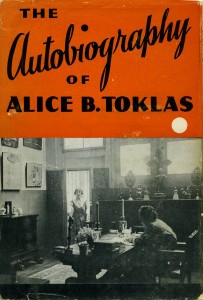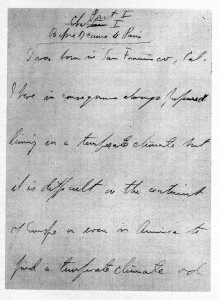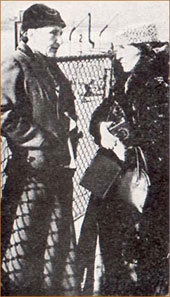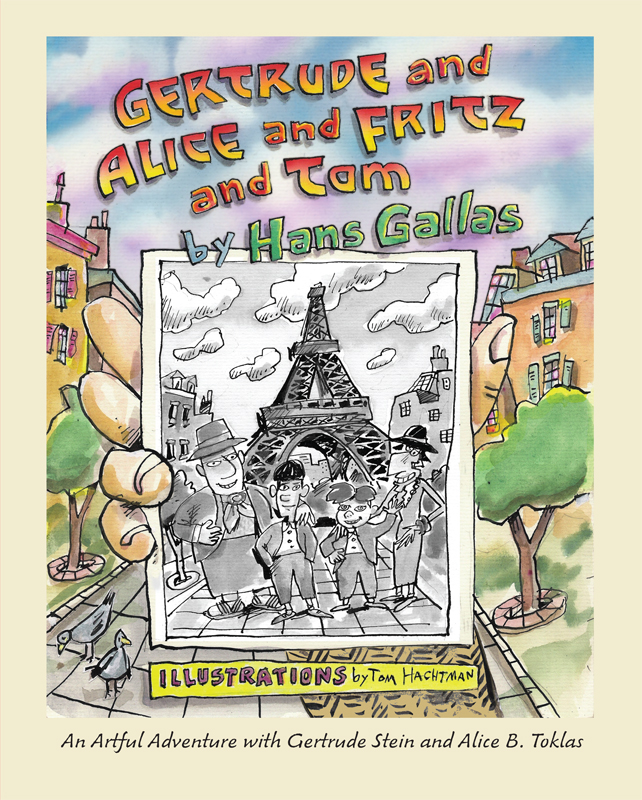“And she has and this is it” is the last line of THE AUTOBIOGRAPHY OF ALICE B. TOKLAS which was first published seventy-six years ago today.
That sentence ended Gertrude Stein’s first bestseller. The initial printing of 5,400 copies in 1933 was more than 10 times as many copies than her last book, MATISSE PICASSO AND GERTRUDE STEIN, which she and Alice had self-published earlier that year. The Literary Guild book club also featured the book as its September selection with an extensive write-up in its membership brochure. The Guild’s Oprah-like imprimatur also helped sales.
A Man Ray photograph appeared on the dust jacket of the first edition showing Gertrude at her writing table and Alice entering the room, but no where on the dust jacket or cover page of the book is the author’s name. And on the back page of the dust jacket, the publisher continues the literary joke by stating:

dust jacket of the 1933 U.S. first edition
“Since the first announcement of the forthcoming publication of this book, innumerable questions have been asked about Alice B. Toklas. Who is this author? What is this extraordinary book that she has written? Does she really exist?”
People soon found out that the author existed and it wasn’t Alice B. Toklas, but Gertrude Stein and many readers got to know her extremely well the following year when GertrudeandAlice embarked on their six-month tour of the U.S.
The book written in Alice’s voice begins with her life in San Francisco, moves to her arrival in Paris in 1907 and then fills in information about Gertrude before the two of them met. It continues with the introduction of the many players-writers, artists, and other friends-who made up their circle.
Many of the familiar names are here – Picasso, Braque, Hemingway, Matisse, Gris, and on and on, but it’s not the name-dropping that makes the book so remarkable or the portrait that it paints of Europe during the first quarter of the 20th century. What makes it remarkable is Alice’s voice captured by Gertrude Stein and put down on the page in a style totally different from the style for which Gertrude was known. And though the style and organization of the book is not what many would view as straight, conventional narrative, it is a far, far cry from TENDER BUTTONS or the word portraits that appeared in MATISSE PICASSO AND GERTRUDE STEIN. (In 1935 a number of the famous people mentioned in the book published a small pamphlet “Testimony Against Gertrude Stein” in which they questioned the accuracy of some of the facts in THE AUTOBIOGRAPHY.)

first hand-written page of THE AUTOBIOGRAPHY
Some have said that Gertrude “sold out” by writing more conventionally and once the book became such a phenomenal success, she herself questioned for a time whether she had made the correct artistic decision. The sequel to THE AUTOBIOGRAPHY, which covers the U. S. lecture tour, EVERYBODY’S AUTOBIOGRAPHY, came out four years later written in a similar style. However, in 1936 her book THE GEOGRAPHICAL HISTORY OF AMERICA OR THE RELATION OF HUMAN NATURE TO THE HUMAN MIND was published by Random House. In that book she was back to her old way of writing. Her friend Bennett Cerf, the publisher, even confessed on the dust jacket of the book that he had no idea of what the book was about. (1000 copies of the book were printed, 200 copies sold and the rest were pulped making it one of the most collectible of Stein’s first editions!)
And so, Happy Anniversary to THE AUTOBIOGRAPHY!
Grab a copy and enjoy it again or enjoy it for the first time and when you reach the last page, Gertrude will be her down right honest, straight forward self:
“About six weeks ago Gertrude Stein said, it does not look to me as if you were ever going to write that autobiography. You know what I am going to do. I am going to write it for you. I am going to write it as simply as Defoe did the autobiography of Robinson Crusoe. And she has and this is it.”
COPYRIGHT HANS GALLAS ©2009



Leave a Reply
You must be logged in to post a comment.